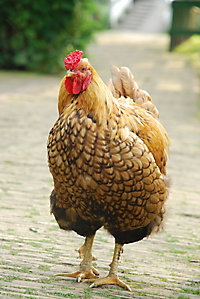http://www.kiddyhouse.com/Farm/Chicken/
http://easyscienceforkids.com/all-about-chickens/
https://www.tillysnest.com/2016/04/kids-and-chickens/
Facts about Chickens (from Tractor Supply Company)

There are more than 25 billion chickens in the world, and dozens of breeds. With so many of them, it seems only natural to want to know more about this peculiar bird. Here are some scientific facts mixed in with some purely fun facts, so enjoy the read!
- The chicken, Gallus gallus domesticus, is a domestic subspecies of the red junglefowl, a member of the pheasant family that is native to Asia. Genetic studies have found that the grey junglefowl also contributed to the chicken's evolution.
- According to the Encyclopædia Britannica, "Humans first domesticated chickens of Indian origin for the purpose of cockfighting in Asia, Africa, and Europe. Very little formal attention was given to egg or meat production..."
- We've already said there are more than 25 billion chickens in the world. This makes the chicken more numerous than any other bird on the planet.
- There are approximately 280 million laying hens producing 50 billion eggs in the U.S. each year.
- Adult male chickens over a year old are called roosters in Australia, Canada, and the U.S.. Males less than a year old are called cockerels. Adult females are hens, and young females less than a year old are called pullets, although in the egg-laying industry, a pullet becomes a hen when she begins to lay eggs. Young chickens are called chicks.
- Chickens begin communicating before they are hatched, when the mother hen makes a purring noise towards her eggs and the chicks peep back at her from inside the unhatched eggs.
- There are approximately 30 distinct vocalizations that chickens use to communicate with each other.
- Chickens are omnivores, meaning they eat seeds and insects, but also have been known to eat mice and lizards.
- Chickens can recognize around 100 different faces.
- Chickens can't fly very far, but they can get airborne enough to make it over a fence.
- The rooster's wattle — the dangly bit beneath his beak — helps him to gain a hen's attention.
- Chickens live in flocks and establish a "pecking order" — an order of dominance/importance. Birds that are higher in the pecking order get priority food access and nesting locations.
- Removing birds from a flock will disturb the pecking order temporarily. Adding to the flock, especially younger birds, will also disturb the pecking order and can lead to fighting and injury (or on rare occasions death), if not done properly.
- Chickens lay eggs of different colors. The colors do not affect the nutritional value of the eggs, but the chickens' diet does affect it.
- Most hens prefer to lay eggs in nests that already have eggs in them. Occasionally, this results in hens trying to lay on top of each other if the nest is small.
- Chickens lay eggs only after receiving a light cue, either from natural sunlight entering a coop or artificial light illuminating a commercial egg hatchery. The light stimulates a photo-receptive gland near the chicken's eye, which in turn triggers the release of an egg cell from the chicken's ovary.
- A chicken will lay bigger and stronger eggs if you change the lighting in a way that makes her think a day is 28 hours long.
- A single hen can produce between 250 and 300 eggs per year.
- A hen turns her eggs about 50 times a day to keep it from sticking to the side of the shell.
- Fertilized eggs take about 21 days to incubate and hatch.
- You can tell whether an egg is fresh or stale by dropping it in water. A fresh egg will sink, but a stale one will float.
- Eggs are a good source of lutein, which promotes eye health. The yolk and white is made of 74% water, 11% fat, and 12% protein. Egg yolks are one of the few foods that naturally contain Vitamin D.
- Chickens have full-color vision.
- Scientists think chickens are the closest living relative of the Tyrannosaurus rex.
- The waste produced by one chicken in its lifetime can supply enough electricity to run a 100-watt bulb for five hours.
- Agricultural researchers have found a carbonization process that converts ordinary poultry manure into granules and powders that can mop up pollutants in water.
- Researchers at NASA are testing a new jet fuel made from chicken fat.